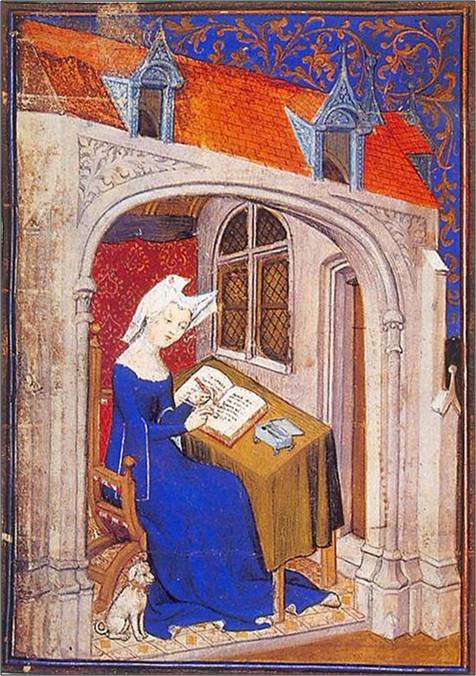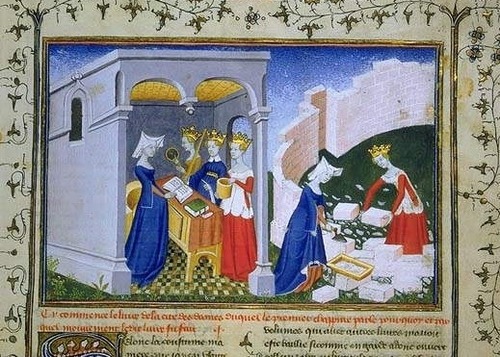 Christine de Pizan, Artemisia Gentileschi, Frida Kahlo, Claude Cahun, and Kara Walker are well-known aritists who chose art as a medium to illustrate their emotions and their beliefs. Some of these women, like Christine de Pizan, Artemisia Gentileschi, and Frida Kahlo were lucky to get exposed art and education because they were either into a wealthy family or their father or husband was a painter. Others, like Claude Cahun and Kara Walker were either inspired by their father or wanted to make a statement. Nonetheless, they all challenged men, pain, and societal norms in one way or another through the form of art.
Christine de Pizan, Artemisia Gentileschi, Frida Kahlo, Claude Cahun, and Kara Walker are well-known aritists who chose art as a medium to illustrate their emotions and their beliefs. Some of these women, like Christine de Pizan, Artemisia Gentileschi, and Frida Kahlo were lucky to get exposed art and education because they were either into a wealthy family or their father or husband was a painter. Others, like Claude Cahun and Kara Walker were either inspired by their father or wanted to make a statement. Nonetheless, they all challenged men, pain, and societal norms in one way or another through the form of art.Christine de Pizan was one the most famous women writers of the Middle Ages. She was born into a wealthy family from Italy. Her father, Thomas Pezano played a huge role in shaping her education as she was growing up. She was able to read and write as well as getting exposed to other areas of education like philosophy and Latin that were originally taught to men. She had strong belief in the equal rights of women. She wrote Cité des Dames (City of Ladies) in response to Boccaccio's De Claris Mulieribus. Boccaccio believed that women were talent-less and that it was very rare to find women who had talent. Pizan went on to refute his remarks by creating City of Ladies to challenge him. According to Chadwick, City of Ladies was based on a metaphorical city in which great women lived safe from slanders of men (35). Within the text, Pizan offered evidence of women's great achievements and was able to use examples to prove her point against Boccaccio. (Her point being that women are capable of being talented.) City of Ladies was a "defense of women in the face of centuries of misogynist writings" (36).
 |
| In this painting from the Book of City of Ladies portrays women being at work and taking charge. |
 |
| Artemisia Gentileschi, 1630s |
 |
| Judith Slaying Holofernes, 1620 |
 |
| The Memory of the Heart, 1937 |
Claude Cahun was most famous for taking pictures of herself "in a range of gender-bending stereotypes. She began taking pictures of herself by the age of eighteen. Cahun works offered a broad exploration of gender, sexuality, and the representation of female nudity in art. Her photographs challenged gender roles. In this autoportait taken in 1929, two Cahuns are separated by a wall. The Cahun in the mirror seems strong and rebellious. The Cahun upfront is boldly drawn withing shiny hair, deep colored lips and pointed gaze. Cahun's reflection portrays two different people in which lets us get a chance to assign the genders based on what we see.
 |
| The End of Uncle Tom |
Kara Walker was inspired to become an artist by her dad at a very early age. Her works are based on creating narratives of the blacks in the "antebellum South" by using large-scale silhouettes. Walker's plan in using silhouettes was to weaken the "preconceptions about the past" by exploiting stereotypes (Chadwick, 492). This caused a controversial issue because some saw it as negative stereotyping and reminding viewers that "racism is subtle and persistent till present day. The End of Uncle Tom is a visual that retells Harriet Beecher Stowe's, Uncle Tom's Cabin.
The amazing aspect of all five artists is that they were able to challenge society and men as well as putting emotion throughout their artwork.
Work Cited:
The Guerrilla Girls' Bedside Companion to the History of Western Art. New York: Penguin, 1998. Print.
Chadwick, Whitney. Women, Art, and Society. New York, NY: Thames and Hudson, 1990.Print.
"Frida Kahlo." Frida Kahlo, Frieda, Paintings, Works, Photos, Drawings, Sketches, Biography, Books, Films, Chronology, Bio, Art, Self Portrait, Painter, Mexican Artist. N.p., n.d. Web. 29 Nov. 2012. <http://www.fridakahlofans.com/>.
Barber, Jeremieh. "Always A Multiple: Claude Cahun at the Jeu De Paume." Public Media. KQED, 02 July 2011. Web. 29 Nov. 2012. <http://www.kqed.org/arts/visualarts/article.jsp?essid=59268>.

No comments:
Post a Comment